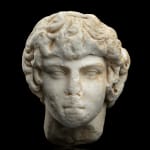Roman
A Roman marble portrait head of Antinous, Hadrianic, circa AD 135
Marble
Height: 12.9 cm
Further images
Carved from a block of fine-grained marble, this head of Antinous depicts him in characteristic form, turning slightly to the left, the ovoid face has a straight brow, almond-shaped eyes...
Carved from a block of fine-grained marble, this head of Antinous depicts him in characteristic form, turning slightly to the left, the ovoid face has a straight brow, almond-shaped eyes gazing to his left with incised irises, smooth cheeks, and what would have been full lips, the face surrounded by abundant tousled curls which completely cover the ears, and a wreath of ivy tied at the nape of the neck. The hair is deeply carved with drilling to enhance.
Provenance
Dr. Horst Ulbo Bauer Collection, Cologne, Germany, acquired before 1968Dr Kurt Kirsch Collection, Germany, acquired from the above in 1981, thence by descent
With Gordian Weber, Cologne, 2011Literature
During an Imperial visit to Egypt in AD 130, Antinous, the young beloved of the Roman emperor Hadrian, drowned in the River Nile in the region of Antinoe (the city on the East bank of the Nile in Upper Egypt that Hadrian then founded in his honour). The exact circumstances of death are still unknown: ancient authors attribute them to fate, suicide, even murder, or a ritual sacrifice (Cassius Dio, Roman History, 69).Hadrian had statues of Antinous dedicated throughout the empire to commemorate his memory. In Egypt, Antinous was also deified, and in accordance with Egyptian custom, the distraught emperor initiated a cult venerating the dead youth, for the Egyptians believed that those who met such a death became assimilated to Osiris, god of the Underworld. Outside Egypt, as worship of the deified Antinous flourished in the East, especially in his homeland, Bithynia, numerous statues of Antinous were erected. He was represented as a beautiful youth, often depicted in the guise of Dionysus/Bacchus, and there are the remains of an ivy wreath in the hair of this portrait.
This head, believed to be from Ephesus originally, is a good example of the sophisticated portrait type created by imperial sculptors to incorporate what must have been actual features of the boy in an idealised image that conveys a god-like beauty. His characteristic facial features include an oval face, smooth complexion, almond-shaped eyes, and full lips, as well as his distinctive hairstyle of thick, wavy locks radiating from the crown of his head. For similar see a small head in the British Museum (acc. no.1973,0302.4): Christoph W. Clairmont, Die Bildnisse des Antinous: Ein Beitrag zur Porträtplastik unter Kaiser Hadrian, 1966, no. 22, p. 46, fig. 18; also in Athens, National Museum, acc. no. 518: Clairmont, op.cit., no. 4 p. 39.
For further reading see: C. Vout, ‘Antinous, Archaeology and History’, Journal of Roman Studies 95, 2005, pp. 80-95; H. Meyer, Antinoos: Die archäologischen Denkmäler, Munich, 1991; C. Vout, Power and Eroticism in Imperial Rome, Cambridge, 2007; R.R.R. Smith and M. Melfi, Antinous, Boy Made God, Oxford, 2018.
Publications
Weltkunst aus Privatbesitz, Cologne, 1968, no. A75, pl. 35.Antiken aus rheinischem Privatbesitz, Bonn-Cologne, 1973, no. 360, p. 220, pl. 163.
H. Meyer, Antinoos, 1991, 100 no. I 78, taf. 90
Arachne, Koln: 1082754





